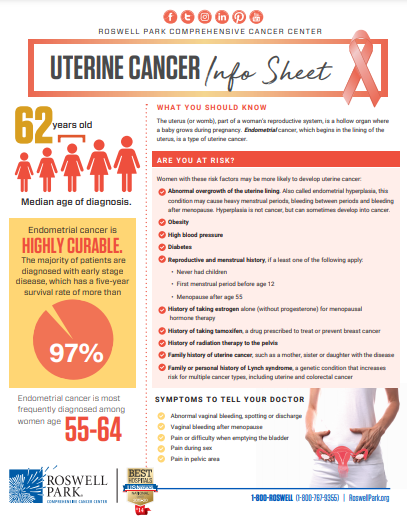The uterus, or womb, is the hollow pear-shaped organ where a baby grows during pregnancy. This organ, along with the ovaries and fallopian tubes, make up the female reproductive system.
Uterine cancer occurs when a change or mutation in cells of the uterus causes them to grow and multiply out of control, forming a collection of abnormal cells called a tumor. While the cervix, the ring of tissue that connects the uterus to the vagina is considered part of the uterus, cancer of the cervix is diagnosed and treated differently. Learn more at Roswell Park’s section on cervical cancer.
Uterine cancer is most commonly found in postmenopausal women and the median age at diagnosis is 63. The uterus is comprised of three main layers, and where your cancer begins and which layers it may spread to becomes important in determining your cancer type and stage and the best treatment options for you. These layers including the:
- endometrium, a thin layer of tissue that lines the inside of the uterus
- myometrium, a muscular, middle layer
- perimetrium, a thin outer lining, also called the serosa
Most uterine cancers are one of these two types:
- Endometrial carcinoma (or endometrial cancer) begins in the endometrium, the lining of the uterus. This is the most common uterine cancer type and accounts for 9 out of ten cases. Endometrial cancer is often diagnosed at early stages and with proper treatment, can often be cured.
- Uterine sarcoma begins in the muscular, middle layer of the uterus. This cancer type is less common and more difficult to treat than endometrial cancer.
Both endometrial cancer and uterine sarcoma have several subtypes. Some of these are considered very rare and can be aggressive cancers. It’s important to know that the gynecologist oncologists at Roswell Park are experts in all uterine cancer types, and our team treats these cancers, common and uncommon, every day.
Uterine cancer diagnosis Types of uterine cancer
What you need to know about uterine cancer.

